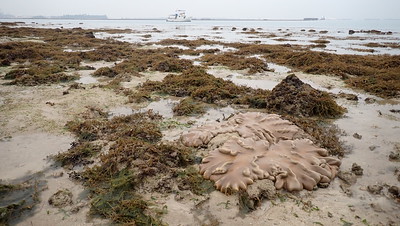How nice to see signs of dugongs here! The corals and seagrasses seemed mostly alright. Kelvin and Russel flew drones and got great views of the shore, and shark! Alas, it seems the Giant clam here is gone.
Kelvin's drone view is an eye opener! Showing the huge terumbu with many small 'cuts' on the margins probably due to boat strikes. It also shows the sandbar and the shallow channel in the middle of the reef flat.
Russel's drone view has Terumbu Pempang Tengah on the horizon.
The rest of the team spotted many crabs, fishes, small sea anemones and other interesting marine life. Sadly, we couldn't find the large Fluted giant clam near the arrival point, not even its empty shell - has it been taken by people? We saw it first in Jun 2014 and the last time we saw it was in Jan 2022. This collage features Kelvin's drone view with Jurong Island on the horizon.
 |
| Collage of photos by the team. Links to their albums below. |
Seagrasses continue to cover almost the entire reef flat from the reef edge to the centre. On the sand bars and among the more reefy parts. Today, large areas in the middle of the shore had very heavy epiphyte grows, and most of the seagrass elsewhere were also coated in epiphytes. Although seagrasses towards the reef edge were more free of epiphytes. The seagrasses were fresh and green on our last survey in May 2023 and Jan 2022. The most common remains Spoon seagrass (mostly small but some large leaves) and Sickle seagrass. I saw only one clump Tape seagrass with leaves cropped short. Rachael saw one flower of the Sickle seagrass!
There has never been a lot of hard corals on this shore. But there is a good variety of common corals with some forming quite large colonies.
Most of the hard corals here are boulder-shaped. Most were alright although I saw a few large colonies that were very pale or had pinkish portions (a sign of stress). As on my last visit in May 2023, I saw more small clusters of Branching montipora coral, perhaps the beginning of a field of them?
I saw a few small to medium-sized leathery soft corals of various kinds near the reef edge. I often wonder why we see large clusters of these on nearby Terumbu Pempang Tengah, but not here. There were also some Asparagus flowery soft corals. I didn't see any that were bleaching.
What is the fate of Terumbu Pempang Laut?
Pulau Hantu and all the terumbus west of it are slated for massive reclamation outlined recently in the Long-Term Plan Review. Singapore's submerged reefs are often out of sight under the high tide and thus forgotten.
Recently, plans were announced for reclamation at Pulau Sudong eastward (red area). These are likely to impact submerged reefs nearby.
The Singapore Blue Plan 2018
Pulau Semakau and nearby islands and submerged reefs have been recommended by the Singapore Blue Plan 2018 for Immediate Conservation Priority. The Blue Plan recommends the intertidal and subtidal marine areas of Pulau Semakau and adjacent Pulau Hantu, and Pulau Jong to be designated Marine Reserve.
The Blue Plan highlights that Pulau Semakau and its associated patch reefs comprise many ecosystems: coral reefs, mangrove areas, intertidal sandflats, seagrass meadows, and coral reefs. The subtidal area of Pulau Jong is larger than the terrestrial area. Pulau Hantu is a popular dive site has seen increasing interest in the past decade due to biodiversity awareness. If protection is accorded to these three islands, zonation plans for use can be implemented to manage tourism and human impacts.
DOWNLOAD the Plan, SUPPORT the Plan! More on the Singapore Blue Plan 2018 site.
Photos by others on this survey
Kelvin Yong
Che Cheng Neo
Rachael Goh
Marcus Ng
Ng Leekiang
Russel Low
Tommy Arden
Vincent Choo











